中级宏观经济学付费版题库5经济增长Ⅱ(最新整理)
中级宏观经济学习题
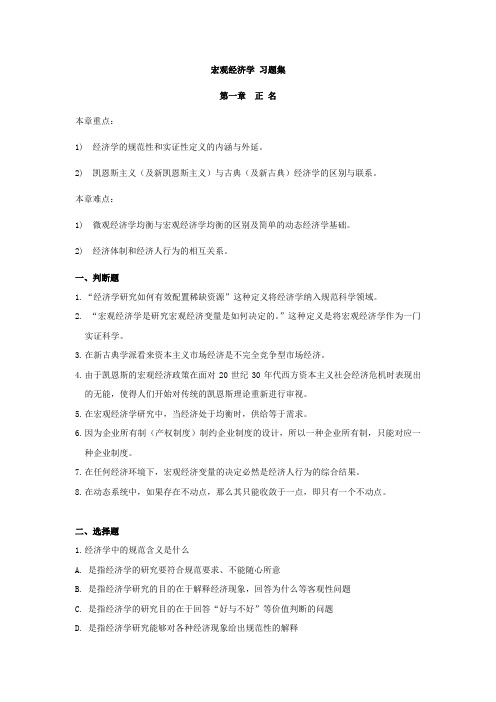
宏观经济学习题集第一章正名本章重点:1)经济学的规范性和实证性定义的内涵与外延。
2)凯恩斯主义(及新凯恩斯主义)与古典(及新古典)经济学的区别与联系。
本章难点:1)微观经济学均衡与宏观经济学均衡的区别及简单的动态经济学基础。
2)经济体制和经济人行为的相互关系。
一、判断题1.“经济学研究如何有效配置稀缺资源”这种定义将经济学纳入规范科学领域。
2.“宏观经济学是研究宏观经济变量是如何决定的。
”这种定义是将宏观经济学作为一门实证科学。
3.在新古典学派看来资本主义市场经济是不完全竞争型市场经济。
4.由于凯恩斯的宏观经济政策在面对20世纪30年代西方资本主义社会经济危机时表现出的无能,使得人们开始对传统的凯恩斯理论重新进行审视。
5.在宏观经济学研究中,当经济处于均衡时,供给等于需求。
6.因为企业所有制(产权制度)制约企业制度的设计,所以一种企业所有制,只能对应一种企业制度。
7.在任何经济环境下,宏观经济变量的决定必然是经济人行为的综合结果。
8.在动态系统中,如果存在不动点,那么其只能收敛于一点,即只有一个不动点。
二、选择题1.经济学中的规范含义是什么A. 是指经济学的研究要符合规范要求、不能随心所意B. 是指经济学研究的目的在于解释经济现象,回答为什么等客观性问题C. 是指经济学的研究目的在于回答“好与不好”等价值判断的问题D. 是指经济学研究能够对各种经济现象给出规范性的解释2.经济学中的实证含义是什么?A. 实证顾名思义就是指经济学的理论要能够指导实践B. 实际上实证的前提是要符合规范的要求C. 经济学研究的目的在于能够回答“应不应该”或“好还是坏”等问题,并能得到来自实践的支持,就是实证D. 通俗地讲,就是回答经济现象是什么?为什么?3.经济学的规范和实证的关系正确理解是A. 规范和实证是彼此对立的,因而经济学要么是规范的,要么就是实证的B. 因为经济学是社会学科,因而本质上经济学始终是规范的C. 规范以实证为基础,实证以规范为目的,因为经济学的目的是造福于人类D. 两者就是一回事,不过是一枚硬币的两面4.以下那个判断属于实证经济学?A. 通货膨胀率下降了B. 失业率太高了C. 经理人的工资不应该太高D. 降低失业率比抑制通货膨胀率更重要5.下列哪种表述属于实证表述A. 政府应该降低税收刺激经济以防经济恶化B. 减少货币供给将降低通货膨胀率C. 央行应该降低货币供给D. 社会应该要求福利领取者去找工作6.以下各项中不属于宏观经济学中探讨的经济变量是:A、就业率B、国民生产总值C、通货膨胀率D、企业产量7.下列题目那些是宏观经济学研究的内容A. 家庭把多少收入用于娱乐消费的决策B. 政府管制对汽车废气的影响C. 高国民储蓄对经济增长的影响D. 企业关于雇佣多少工人的决策8.下列对市场经济的描述中不属于凯恩斯学派观点的是:A、信息传递不对称B、未来不能合理预期C、完全竞争市场D、价格调整具有粘性9.在新古典经济学看来,资本主义市场经济是:A. 不完全竞争的B. 信息是不完全的,具有非对称性C. 预期具有不确定性D. 具有充分弹性,能够有效地进行自我调整,因而政府的干预是不必要的10.经济学中的理性人是指什么?A. 是指经济主体都是自私自利之徒B. 是指经济主体在做经济决策时,都充满理性、计算得失以求自身利益最大化C. 一个利他主义者,绝对不会是一个理性人D. 理性人是经济学中最不现实的假设,它将经济学研究带入了歧途,老早就应该抛弃11.一个国家的经济体制可以靠什么来区分A. 社会的福利水平B. 是不是拥有私人财产C. 社会经济资源的分配和调节机制,基本的企业制度D. 看什么样的政党在执政9.有什么样的经济运行机制,就会有什么样的企业制度你认为正确否A. 客观讲,经济运行机制和企业制度之间并不是一个严格的一一对应关系,同时它们之间又确实存在着相互适应的问题B. 不正确,因为经济运行机制与企业制度之间并不存在彼此决定的关系C. 应该是企业制度决定经济运行机制D. 这个问题太复杂,根本就说不清10.尽管经济体制制约着经济人(个人、企业、政府等)的行为,经济人仍有某些共性比如:A. 企业按照市场价格决定产量B. 政府追求低失业率低通货膨胀C. 追求自身利益最大化D. 企业追求市场份额和稳定增长11.下面关于经济体制的描述中哪个是错误的:A. 经济体制是影响经济环境最重要的因素之一B. 经济体制包括经济运行机制和企业制度C. 经济体制是经济资源的调节和分配机制D. 构成经济体制的两大基本要素必须相互适应12.下列描述中哪个是错误的:A. 新古典学派和凯恩斯学派在经济学研究的某一阶段被当时在学术界占统治地位的经济学家们结合起来,组成新古典综合派中微观经济学和宏观经济学两大体系。
曼昆《宏观经济学》课后习题及详解(经济增长Ⅱ:技术、经验和政策)【圣才出品】

第9章经济增长Ⅱ:技术、经验和政策一、概念题1.劳动效率(efficiency of labor)答:劳动效率是指单位劳动时间的产出水平,反映了社会对生产方法的掌握和熟练程度。
当可获得的技术改进时,劳动效率会提高。
当劳动力的健康、教育或技能得到改善时,劳动效率也会提高。
在索洛模型中,劳动效率(E)是表示技术进步的变量,反映了索洛模型劳动扩张型技术进步的思想:技术进步提高了劳动效率,就像增加了参与生产的劳动力数量一样,所以在生产函数中的劳动力数量上乘以一个劳动效率变量,形成了有效工人概念,这使得索洛模型在稳态分析中纳入了外生的技术进步。
2.劳动改善型技术进步(labor-augmenting technological progress)答:劳动改善型技术进步是指技术进步提高了劳动效率,就像增加了参与生产的劳动力数量一样,所以在生产函数中的劳动力数量上乘以一个劳动效率变量,以反映外生技术进步对经济增长的影响。
劳动改善型技术进步实际上认为技术进步是通过提高劳动效率而影响经济增长的。
它的引入形成了有效工人的概念,从而使得索洛模型能够以单位有效工人的资本和产量来进行稳定状态研究。
3.内生增长理论(endogenous growth theory)答:内生增长理论是用规模收益递增和内生技术进步来说明一个国家长期经济增长和各国增长率差异的一种经济理论,其重要特征就是试图使增长率内生化。
根据其依赖的基本假定条件的差异,可以将内生增长理论分为完全竞争条件下的内生增长模型和垄断竞争条件下的内生增长模型。
按照完全竞争条件下的内生增长模型,使稳定增长率内生化的两条基本途径就是:①将技术进步率内生化;②如果可以被积累的生产要素有固定报酬,那么可以通过某种方式使稳态增长率受要素的积累影响。
内生增长理论是抛弃了索洛模型外生技术进步的假设,以更好地研究技术进步与经济增长之间的关系的理论。
它认为经济增长是可以内生持续的,不会达到索洛模型的稳定状态。
宏观经济学复习题库2

宏观经济学复习题库一.单项选择(本部分共60小题,每题1分,共60分)1.以下项目应计入GDP的是(C )A.李某从房地产交易市场以15万元购买二手房一套B.面粉厂卖给面包厂5000元的面粉C.孙某靠打工一年净收入1.8万元D.张某在股票市场花28000元购入某股票,赢利5000元2.在两部门经济中,国民收入均衡的条件是指( D )A.事后统计的投资等于储蓄B.实际投资等于实际储C.投资与储蓄总是相等D.计划投资等于计划储蓄3.同时采用扩张性的财政政策和货币政策,r和y如何变化(D )A. y 增加,r减小B. y减小,r减小C. y 减小,r增加D. y 增加,r不确定4.在货币需求曲线的水平阶段,下面说法错误的是(A )A.货币供给增加,利率水平下降B.货币政策无效C.投机性货币需求无限D.处于流动偏好陷阱5.下面有关财政政策效果的表述正确的是( A )A.其他条件不变,b越大财政政策的效果越明显B.其他条件不变,d越小财政政策的效果越不明显C.其他条件不变,h越大财政政策的效果越不明显D.其他条件不变,k越大财政政策的效果越明显6.以就业量为自变量的短期宏观生产函数表示随着就业量的增加( B )A.总产量以递增的速度增加B.总产量以递减的速度增加C.总产量以不变的速度增加D.总产量先以递减的速率后以递增的速率增加7.以下那一项不是中央银行的职能(D )A.代表国家发行货币 B.为商业银行保存准备金C.代理国库 D.吸收企业存款8.若边际储蓄倾向为0.25,则边际消费倾向为( B )A. 0.25B. 0.75C. 1.0D. 1.259.工资上涨引起的通货膨胀也称为( B )通货膨胀。
A.需求拉动型B.成本推进型C.结构性D.隐性10.货币创造乘数的大小取决于(C )A.货币供给量B.税率C.法定准备率D.银行利息率11.在下列情况下,转移支付乘数最大的是(A)A.MPC=0.9B.MPC=0.8C. MPS=0.75D.MPS=0.512.假定货币M和p不变,货币需求为收入和利率的函数,收入增加时( A )A.货币交易需求增加,利率上升B.货币交易需求增加,利率下降C.货币交易需求减少,利率上升D.货币交易需求减少,利率下降13.若经济中存在周期性失业,为降低失业率可釆取的财政政策是(A )A.增加政府支出B.提高个人所得税C.减少政府转移支付D.提高企业所得税率14.在开放经济中(A )A.均衡国民收入为y=C +I+G+NXB.NX减少时,国民收入水平提高,NX增加时,国民收入水平下降C.出口是一个内生变量,不由本国收入决定D.进口是一个外生变量,不由本国左右15.当LM曲线呈垂直线时,意味着(B )A.处于凯恩斯区域B.财政政策无效C.货币政策无效D.投机需求无限16.假定总供给曲线斜率为正,减低个人所得税率将( A)A.提高价格水平和实际产出B.提高价格水平但不影响实际产出C.提高实际产出但不影响价格水平D.对价格水平和产出均无影响17.已知充分就业的国民收入是10000亿美元,实际国民收入为9800亿美元,边际消费倾向是80%,在增加100亿美元的投资后,经济将发生(A)A.需求拉上的通货膨胀B.成本推进的通货膨胀C.结构性通货膨胀D.需求不足的失业18.当不可预期的通货膨胀发生时,不利于(B)A.债务人、政府;B.债权人、雇员;C.债务人、雇员;D.债权人、政府19.下列问题中不属于宏观经济学研究范围的是(A)A.大蒜价格上升的原因B.CPI上升的原因C.政府预算赤字对通货膨胀的影响D.国民生产总值的决定20.今年的名义国民生产总值大于去年的名义国民生产总值,说明(D)A.今年物价水平一定比去年提高了B.今年生产的物品和劳务总量一定比去年增加了C.今年物价水平和实物产量水平一定都比去年提高了D.以上三种说法都不一定正确21.消费曲线位于45º线的上方表明,储蓄是(C )。
中级宏观经济学题库

、概念辨析1 •国内生产总值(GDP)与国民生产总值(GNP )2.政府支出与政府购买3.国民生产总值与国民收入4.消费者价格指数与 GDP 消胀指数5.固定汇率制与可变汇率制6.预算盈余与充分就业预算盈余7.真实汇率与购买力平价8.经常账户与资本账户9 •商品市场均衡曲线(IS)与货币市场均衡曲线(LM)10 .边际消费倾向与边际储蓄倾向1 1 .法定贬值与真实贬值1 2 .凯恩斯消费理论与 LC-PIH 消费理论、简述题(图解题)1 、恒等式“储蓄等于投资” (如果是四部门经济则为“国民储蓄等于国民投资” )在传统意义上很好理解,比如你把钱存银行,银行贷款给企业投资。
那么假设人把钱放枕头底下,该恒等式还成立吗?2. 如果甲乙两个国家合并成一个国家,对 GDP 总和会有什么影响(假定两国产出不变)?3.在实行累进税制的国家,比例所得税为何能对经济起到自动稳定器的作用?4.写出现代菲利普斯曲线方程,配以图形简述其如何解释经济中的滞胀现象?5.货币需求对利率的弹性越大,货币政策就越无效的判断是否正确6.政府采购支出增加一定会挤出私人投资和导致通货膨胀吗?7.古典学派和凯恩斯主义的总供给观点各自基于怎样的假定前提以及适合在什么情况下分析宏观经济问题?8.在国民收入核算中, Y C I G NX ;在均衡收入的决定中,只有当 Y AD 时, Y CI G NX 才会成立。
这是否存在矛盾,并请说明理由。
9 .名义货币存量的增加使 AD 曲线上移的程度恰恰与名义货币增加的程度一致,为什么?10 .封闭经济中的IS曲线和开放经济中的IS曲线哪一个更陡峭?11 •贸易伙伴收入提高、本国货币真实贬值将对本国IS曲线产生何种影响?1 2 .凯恩斯学派认为货币政策的传递机制包含哪些环节?最主要的环节是什么?13 .经济处于充分就业状态。
若政府要改变需求构成,从消费转向投资,但不允许超过充分就业水平。
需要采取何种形式的政策组合?运用IS—LM 模型进行分析。
经济中级试题库及答案
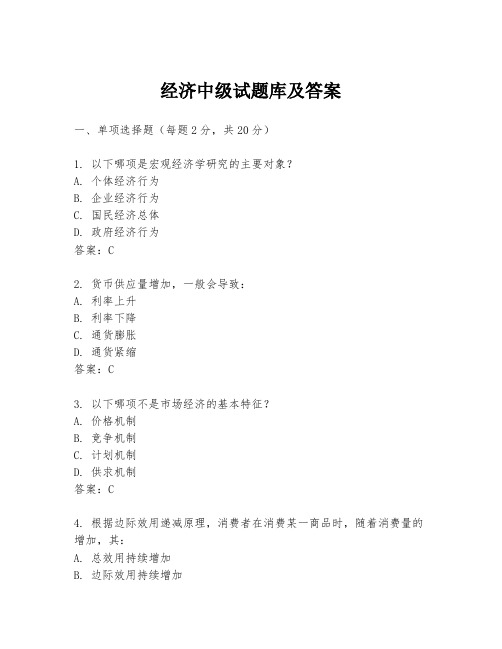
经济中级试题库及答案一、单项选择题(每题2分,共20分)1. 以下哪项是宏观经济学研究的主要对象?A. 个体经济行为B. 企业经济行为C. 国民经济总体D. 政府经济行为答案:C2. 货币供应量增加,一般会导致:A. 利率上升B. 利率下降C. 通货膨胀D. 通货紧缩答案:C3. 以下哪项不是市场经济的基本特征?A. 价格机制B. 竞争机制C. 计划机制D. 供求机制答案:C4. 根据边际效用递减原理,消费者在消费某一商品时,随着消费量的增加,其:A. 总效用持续增加B. 边际效用持续增加C. 边际效用逐渐减少D. 总效用逐渐减少答案:C5. 以下哪项不是货币政策工具?A. 利率政策B. 公开市场操作C. 汇率政策D. 存款准备金率答案:C6. 以下哪项不是财政政策的调节手段?A. 税收B. 政府支出C. 转移支付D. 利率调整答案:D7. 以下哪项是通货膨胀的主要原因?A. 货币供应量增加B. 货币供应量减少C. 货币需求增加D. 货币需求减少答案:A8. 以下哪项是凯恩斯主义经济学的核心观点?A. 自由市场B. 政府干预C. 货币主义D. 供给学派答案:B9. 以下哪项是市场经济中价格形成的基础?A. 政府定价B. 市场供求关系C. 企业定价D. 消费者定价答案:B10. 以下哪项是经济全球化的主要表现?A. 国际贸易B. 国际投资C. 国际旅游D. 全部选项答案:D二、多项选择题(每题3分,共15分)1. 以下哪些因素可能导致经济衰退?A. 需求不足B. 供给过剩C. 通货膨胀D. 失业率上升答案:A, B, D2. 以下哪些是货币政策的传导机制?A. 利率机制B. 货币供应量机制C. 汇率机制D. 信用机制答案:A, B, D3. 以下哪些是财政政策的调节手段?A. 税收调整B. 政府支出调整C. 利率调整D. 转移支付调整答案:A, B, D4. 以下哪些是市场经济体制的特点?A. 市场决定资源配置B. 政府直接干预经济C. 企业自主经营D. 价格由市场供求决定答案:A, C, D5. 以下哪些是经济全球化的影响?A. 国际贸易增加B. 国际投资增加C. 国际竞争加剧D. 国际合作加强答案:A, B, C, D三、判断题(每题2分,共10分)1. 市场经济体制下,政府不参与经济活动。
中级宏观经济学考试资料整理.doc
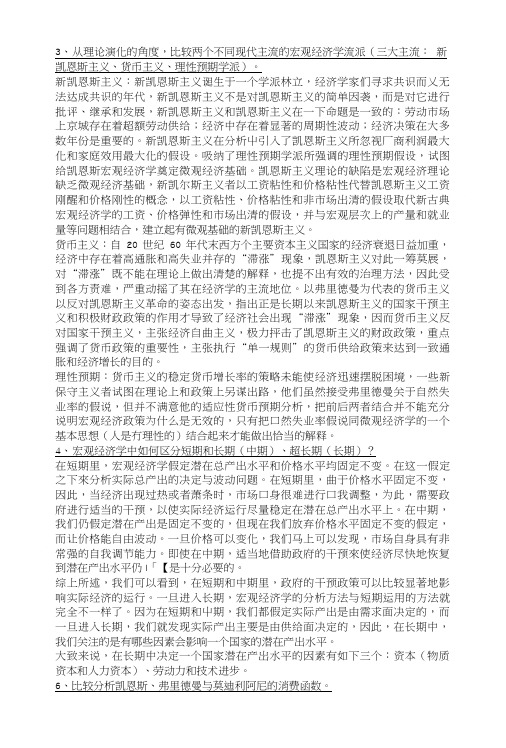
3、从理论演化的角度,比较两个不同现代主流的宏观经济学流派(三大主流:新凯恩斯主义、货币主义、理性预期学派)。
新凯恩斯主义:新凯恩斯主义诞生于一个学派林立,经济学家们寻求共识而乂无法达成共识的年代,新凯恩斯主义不是对凯恩斯主义的简单因袭,而是对它进行批评、继承和发展,新凯恩斯主义和凯恩斯主义在一下命题是一致的:劳动市场上京城存在着超额劳动供给;经济中存在着显著的周期性波动;经济决策在大多数年份是重要的。
新凯恩斯主义在分析屮引入了凯恩斯主义所忽视厂商利润最大化和家庭效用最大化的假设。
吸纳了理性预期学派所强调的理性预期假设,试图给凯恩斯宏观经济学奠定微观经济基础。
凯恩斯主义理论的缺陷是宏观经济理论缺乏微观经济基础,新凯尔斯主义者以工资粘性和价格粘性代替凯恩斯主义工资刚醒和价格刚性的概念,以工资粘性、价格粘性和非市场出清的假设取代新古典宏观经济学的工资、价格弹性和市场出清的假设,并与宏观层次上的产量和就业量等问题相结合,建立起有微观基础的新凯恩斯主义。
货币主义:自20世纪60年代末西方个主要资本主义国家的经济衰退日益加重,经济中存在着高通胀和高失业并存的“滞涨”现象,凯恩斯主义对此一筹莫展,对“滞涨”既不能在理论上做出清楚的解释,也提不出有效的治理方法,因此受到各方责难,严重动摇了其在经济学的主流地位。
以弗里徳曼为代表的货币主义以反对凯恩斯主义革命的姿态出发,指出正是长期以来凯恩斯主义的国家干预主义和积极财政政策的作用才导致了经济社会出现“滞涨”现象,因而货币主义反对国家干预主义,主张经济自曲主义,极力抨击了凯恩斯主义的财政政策,重点强调了货币政策的重要性,主张执行“单一规则”的货币供给政策来达到一致通胀和经济增长的目的。
理性预期:货币主义的稳定货币增长率的策略未能使经济迅速摆脱困境,一些新保守主义者试图在理论上和政策上另谋出路,他们虽然接受弗里德曼关于自然失业率的假说,但并不满意他的适应性货币预期分析,把前后两者结合并不能充分说明宏观经济政策为什么是无效的,只有把口然失业率假说同微观经济学的一个基本思想(人是冇理性的)结合起来才能做出恰当的解释。
宏观经济学题库(带答案版)

宏观经济学最新题库(带答案版)————————————————————————————————作者:————————————————————————————————日期:第十二章国民收入核算一、名词解释1.国内生产总值(GDP):经济社会(一国或一个地区)在一定时期(通常指一年)内使用生产要素生产的全部最终产品(物品或劳务)的市场价值。
2. 国民收入(NI):从国内生产总值中扣除间接税和企业转移支付加政府补助金,就得到一国生产要素在一定时期内提供生产性服务所得报酬即工资、利息、利润和租金的总和意义上的国民收入。
3.个人可支配收入:从个人收入中扣除向政府缴纳的税金,即得个人可支配收入。
人们可以用来消费和储蓄的收入。
4.国民生产总值:是一个国民概念,指一国国民所拥有的全部生产要素在一定时期内生产的最终产品的市场价值。
5.实际国内生产总值:用从前某一年作为基期价格计算出来的全部最终产品的市场价值。
6.GDP折算指数:是名义的GDP和实际的GDP的比率。
7.最终产品:在一定时期内生产的并由其最后使用者购买的产品和劳务。
二、判断题1. 宏观经济学以收入分析中心,故又可称收入理论。
√2. GDP被定义为经济社会在一定时期内运用生产要素所生产的全部产品的市场价值。
×3. 一个在日本工作的美国公民的收入是美国GDP的一部分,也是日本GNP的一部分。
×4. GDP中扣除资本折旧,就可以得到NDP。
√5. 2012年我国城镇居民个人可支配收入为200543元,它是人们可用来消费或储蓄的收入。
√6. 四部门经济的投资储蓄恒等式为I=S+(T-G)+(M-X+Kr)。
√7. GDP折算指数是实际GDP与名义GDP的比率。
×8. 国民收入核算体系将GDP作为核算国民经济活动的核心指标。
√9. 政府转移支付应计入国内生产总值GDP 中。
×10. 若某企业年生产50万$的产品,只销售掉40万$的产品,则当年该企业所创造的GDP为40万$。
宏观经济学题库

宏观经济学试题库一、判断题(每题1分)1、如果市场利率低于均衡利率,人们就会卖出有价证券。
(√)2、如果市场利率低于均衡利率,人们就会买入有价证券。
(×)3、某公司生产的汽车多卖出去一些比少卖一些时GDP要增多一些。
(×)4、某国对实际货币余额需求减少,可能是由于利率上升。
(√)5、货币交易需求曲线的变动导致LM曲线反方向变动。
(×)6、货币投机需求曲线的变动导致LM曲线同方向变动。
(×)7、一般物价水平不影响货币需求。
(×)8、货币需求对利率越敏感,即货币需求的利率系数越大,货币政策的效果越大。
(×)9、货币供给的减少会使LM曲线向左方移动。
(√)10、货币乘数是银行所创造的货币量与最初存款的比例。
(×)11、有通货漏出的货币乘数要小于简单的货币乘数。
(√)12、净投资不可能是负数。
(×)13、总投资不可能是负数。
(√)14、LM曲线越陡,财政政策的效力就越小。
(√)15、LM曲线平坦,IS曲线越垂直,则增加货币供给不会影响均衡收入(√)16、LM曲线右移且IS曲线斜率不变时,LM曲线越陡,货币政策效果越大。
(√)17、LM曲线为一条水平线时,扩张性货币政策没有效应,财政政策对实际国民生产总值的影响最大。
(√)18、在LM曲线斜率不变的情况下,IS曲线的弹性小,则财政政策的效果差。
(×)19、在LM曲线上任何一点,利率与实际国民生产总值的结合都实现了货币需求等于货币供给。
(√)20、在物价水平不变时,中央银行在公开市场上购买政府债券使LM曲线向右方移动。
(√)21、若IS斜率曲线不变, LM曲线越陡峭,财政政策效果越大。
(×)22、当IS曲线右移且LM曲线斜率不变时,IS曲线越陡,财政政策效果越小。
(×)23、给定总产出不变,当政府支出增加时,IS曲线将向左下方移动。
(×)24、如果净税收增加10亿元,会使IS曲线左移税收乘数乘以10亿元。
中级宏观经济学(Macroeconomics)考试试题答案
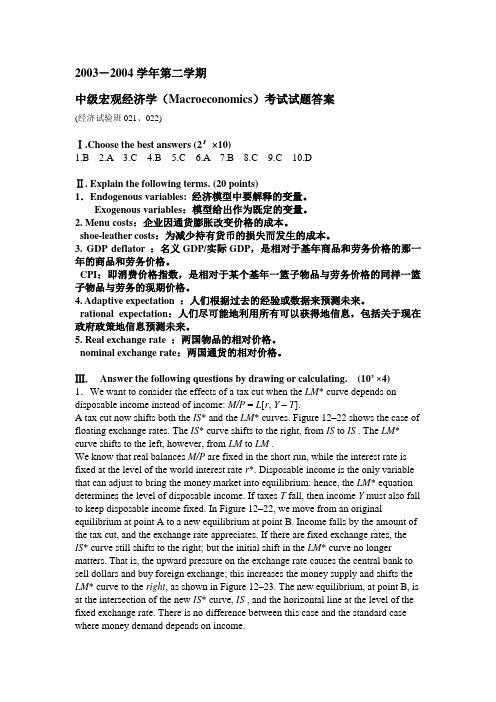
2003-2004学年第二学期中级宏观经济学(Macroeconomics)考试试题答案(经济试验班021、022)Ⅰ.Choose the best answers (2'×10)1.B2.A3.C4.B5.C6.A7.B8.C9.C 10.DⅡ. Explain the following terms. (20 points)1.Endogenous variables: 经济模型中要解释的变量。
Exogenous variables:模型给出作为既定的变量。
2. Menu costs:企业因通货膨胀改变价格的成本。
shoe-leather costs:为减少持有货币的损失而发生的成本。
3. GDP deflator :名义GDP/实际GDP,是相对于基年商品和劳务价格的那一年的商品和劳务价格。
CPI:即消费价格指数,是相对于某个基年一篮子物品与劳务价格的同样一篮子物品与劳务的现期价格。
4. Adaptive expectation :人们根据过去的经验或数据来预测未来。
rational expectation:人们尽可能地利用所有可以获得地信息,包括关于现在政府政策地信息预测未来。
5. Real exchange rate :两国物品的相对价格。
nominal exchange rate:两国通货的相对价格。
Ⅲ.Answer the following questions by drawing or calculating. (10’ ×4) 1.We want to consider the effects of a tax cut when the LM* curve depends on disposable income instead of income: M/P = L[r, Y –T].A tax cut now shifts both the IS* and the LM* curves. Figure 12–22 shows the case of floating exchange rates. The IS* curve shifts to the right, from IS to IS . The LM* curve shifts to the left, however, from LM to LM .We know that real balances M/P are fixed in the short run, while the interest rate is fixed at the level of the world interest rate r*. Disposable income is the only variable that can adjust to bring the money market into equilibrium: hence, the LM* equation determines the level of disposable income. If taxes T fall, then income Y must also fall to keep disposable income fixed. In Figure 12–22, we move from an original equilibrium at point A to a new equilibrium at point B. Income falls by the amount of the tax cut, and the exchange rate appreciates. If there are fixed exchange rates, theIS* curve still shifts to the right; but the initial shift in the LM* curve no longer matters. That is, the upward pressure on the exchange rate causes the central bank to sell dollars and buy foreign exchange; this increases the money supply and shifts the LM* curve to the right, as shown in Figure 12–23. The new equilibrium, at point B, is at the intersection of the new IS* curve, IS , and the horizontal line at the level of the fixed exchange rate. There is no difference between this case and the standard case where money demand depends on income.2. a.将生产函数两边同时除以效率工人,则有:()4.04.06.04.0k L E K L E L E K L E Y y =⎪⎭⎫ ⎝⎛⨯=⨯⨯=⨯=b .s=0.25 δ=5% n=2% g=3%; 带入经济稳定的条件:38.15.275.0)1(*84.15.2*6.45.2*1.025.0)()(3/23/24.03/54.0≈⨯=-=≈==≈==⋅++=⋅y s c k y k kk kg n k f s δc.当g 变为5%时,有: 63.11225*4.31225*12.025.0)()(3/24.03/54.0≈⎪⎭⎫ ⎝⎛==≈⎪⎭⎫ ⎝⎛==⋅++=⋅k y k kk kg n k f s δ 这种变化导致了效率工人的人均资本量减少,效率工人的人均产量下降;但总产出会增加。
《宏观经济学》考试题库及答案(五)
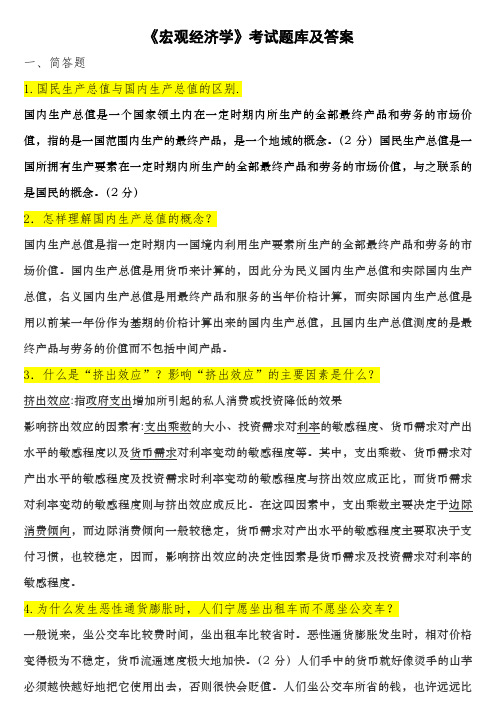
《宏观经济学》考试题库及答案一、简答题1.国民生产总值与国内生产总值的区别.国内生产总值是一个国家领土内在一定时期内所生产的全部最终产品和劳务的市场价值,指的是一国范围内生产的最终产品,是一个地域的概念。
(2分)国民生产总值是一国所拥有生产要素在一定时期内所生产的全部最终产品和劳务的市场价值,与之联系的是国民的概念。
(2分)2.怎样理解国内生产总值的概念?国内生产总值是指一定时期内一国境内利用生产要素所生产的全部最终产品和劳务的市场价值。
国内生产总值是用货币来计算的,因此分为民义国内生产总值和实际国内生产总值,名义国内生产总值是用最终产品和服务的当年价格计算,而实际国内生产总值是用以前某一年份作为基期的价格计算出来的国内生产总值,且国内生产总值测度的是最终产品与劳务的价值而不包括中间产品。
3.什么是“挤出效应”?影响“挤出效应”的主要因素是什么?产出水平的敏感程度及投资需求时利率变动的敏感程度与挤出效应成正比,而货币需求付习惯,也较稳定,因而,影响挤出效应的决定性因素是货币需求及投资需求对利率的敏感程度。
4.为什么发生恶性通货膨胀时,人们宁愿坐出租车而不愿坐公交车?一般说来,坐公交车比较费时间,坐出租车比较省时。
恶性通货膨胀发生时,相对价格变得极为不稳定,货币流通速度极大地加快。
(2分)人们手中的货币就好像烫手的山芋因坐公共汽车所耗费的时间里所发生的货币贬值造成的损失要少得多,而坐出租车虽然多费钱,但可以少受自己所拥有的货币贬值的损失。
(2分)这样,从机会成本的角度考虑,人们宁愿坐出租车而不愿费时坐公交车。
5.松财政政策、松货币政策与紧财政政策、松货币政策两种不同组合产生的政策效果有什么不同?当社会有效需求严重不足时,财政、货币选择双松政策。
财政增支减税,中央银行降低利率,扩大信贷,增加货币供应量,两者配合对经济产生扩张效应。
当整体经济状况良好,为了促使经济更快发展时,采取紧财政、松货币的政策选择。
《宏观经济学》题库及答案

《宏观经济学》题库及答案一、名词解释1.国民生产总值:2.乘数:3.自然失业:4.国内生产总值:5.总供给曲线:6.周期性失业:7.IS曲线:8.供给管理:9.回波效应:10.LM曲线:11.奥肯定律:12.挤出效应:二、填空题1.国民经济核算体系以法所计算出的国民生产总值为标准。
2.根据简单的国民收入决定模型,均衡的国民收入是由决定的。
3.只有在社会上各种资源充分利用时,乘数才发生作用。
4.自发总需求增加的时,IS曲线向移动;5.在凯恩斯主义总供给曲线时,总需求增加会使国民收入,价格水平。
6.由于工资刚性所引起的失业称为。
7.潜在的国民收入指的国民收入水平。
8.消费可以分为两个部分,一部分是不取决于收入的,另一部分是随收入变动而变动的。
9.货币供给量增加,LM曲线向移动。
10.在资源尚未得到充分利用情况下,采用刺激的政策来对付通货膨胀更为有利。
11.当就业人数为1600万,失业人数为400万时,失业率为。
12.受抑制的通货膨胀之所以存在,主要是由于政府实行了严格的与。
13.经济周期可以分为和两个大的阶段。
14.债券价格与债券收益的大小成比,与利息率的高低成比。
15.某银行吸收存款500万元,按规定应留100万元作为准备金,这时的法定准备率为;通过银行的信贷活动,可以创造出的货币额为。
16.国际收支平衡表中的项目分为、、三类。
17.对外贸易政策可以分为和两类。
18.衡量通货膨胀的指标是。
19.中周期是法国经济家提出的一种为期年的经济周期。
20.哈罗德模型认为,短期中实现经济稳定增长的条件是、与相一致。
21.具有内在稳定器作用的财政政策,主要是、以及。
22.衡量一个国家开放程度的指标是与或之间的比率。
三、选择题1.国民生产总值与国民生产净值之间的差别是:()A、直接税B、间接税C、折旧2.根据消费函数,引起消费增加的因素是:()A、价格水平下降B、收入增加C、储蓄增加3.利息率提高时,货币的投机需求将:()A、增加B、不变C、减少4.短期总供给曲线向右下方移动表示:()A、价格水平上升,总供给增加B、价格水平不变,总供给增加C、价格水平不变,总供给减少5.假设某个国家的总人口数为3000万人,就业者为1500万人,失业者为500万人,则该国的失业率为:()A、17%B、34%C、25%6.在通货膨胀不能完全预期的情况下,通货膨胀将有利于:()A、债务人B、债权人C、工人7.在下列三种产品中应该计入当年国民生产总值的是:()A、当年生产的拖拉机B、去年生产而在今年销售出去的拖拉机C、某人去年购买而在今年转售给他人的拖拉机8.根据储蓄函数,引起储蓄增加的因素是:()A、收入增加B、利息率提高C、人们预期未来的价格水平要上升9.自发总需求增加100万元,使国民收入增加了1000万元,那么时的边际消费倾向为:()A、100%B、10%C、90%10.在LM曲线不变的情况下,自发总需求增加会引起:()A、国民收入增加,利率上升B、国民收入增加,利率不变C、国民收入增加,利率下降11.根据菲利浦斯曲线,降低通货膨胀率的办法是:()A、减少货币供给量B、降低失业率C、提高失业率12.衡量一国开放程度高低的标准是:()A、进口与国民生产总值的比率B、出口与国民生产总值的比率C、净出口与国民生产总值的比率13.认为在长期与短期中都不存在菲利浦斯曲线所表示的失业率与通货膨胀率之间交替关系的经济学流派是:()A、凯恩斯主义学派B、货币主义学派C、理性预期学派14.假定资本量为100万,所生产的产量为50万,则资本——产量比率为:()A、50万/100万=0.5B、100万/50万=2C、100万/(100万+50万)=0.6715.在以下三种政策工具中,属于需求管理的是:()A、收入政策B、人力政策C、货币政策16.属于国际收支平衡表中资本项目的是:()A、一国为别国提供保险的收入B、一国对别国劳务出口的收入C、一国在别国发行债券的收入17.在开放经济中,出口的增加将引起:()A、国民收入增加,贸易收支状况改善B、国民收入增加,贸易收支状况恶化C、国民收入增加,贸易收支状况不变18.在经济学中M1是指:()A、现金和一切形式的储蓄存款B、现金或通货C、现金与商业银行的活期存款19.50-60年一次的周期称为:()A、朱格拉周期B、基钦周期C、康德拉季耶夫周期20.当法定准备率为20%,商业银行最初所吸收的存款为10000美元时,银行所能创造的货币总量为:()A、2000美元B、8000美元C、50000美元21.属于国际收支平衡表中的经常项目的是:()A、国外政府在本国的存款B、本国在外国发行股票的收入C、外国居民在本国旅游的支出四、判断题1.个人收入等于消费与储蓄之和。
宏观经济学题库

宏观经济学题库一、名词解释国内生产总值实际国内生产总值名义国内生产总值国内生产净值国民收入个人收入个人可支配收入政府转移支付消费函数平均消费倾向边际消费倾向储蓄函数投资乘数税收乘数政府购买乘数平衡预算乘数资本边际效率IS曲线灵活偏好流动偏好陷阱货币需求LM曲线财政政策货币政策古典主义极端挤出效应非自愿失业结构性失业经济增长自动稳定器功能财政斟酌使用的财政政策充分就业预算盈余货币创造乘数基础货币法定准备金公开市场业务自然失业率单一政策规则菲利普斯曲线经济增长经济周期黄金分割律倒U字假说通货膨胀成本推进通货膨胀二、判断题1、宏观经济学以收入和就业为分析中心,故又可称收入理论或就业理论。
2、GDP被定义为经济社会在一定时期内运用生产要素所生产的全部产品的市场价值。
3、一个在日本工作的美国公民的收入是美国GDP的一部分,也是日本GNP的一部分。
4、GDP中扣除资本折旧,就可以得到NDP。
5、个人收入即为个人可支配收入,是人们可随意用来消费或储蓄的收入。
6、三部门经济的投资储蓄恒等式为I=S+(T-G)。
7、GDP折算指数是实际GDP与名义GDP的比率。
8、国民收入核算体系将GDP作为核算国民经济活动的核心指标。
9、政府转移支付应计入国民生产总值GDP 中。
10、若某企业年生产50万$的产品,只销售掉40万$的产品,则当年该企业所创造的GDP 为40万$。
11、某出租车司机购买了一辆产于1992年的小轿车,该司机为此付出的10万¥的购车费应计入1996年的GDP中。
12、用支出法核算GDP时,政府公债利息不应计入GNP中。
13、用收入法核算国民生产者总值时,资本折旧应计入GDP中。
14、只有经济处于充分就业时,I=S恒等式才成立。
15、在简单国民收入决定理论中,均衡产出是指与总需求相等的产出。
16、在两部门经济中,均衡产出公式为y=c+i 其中c,i 是指实际消费和实际投资。
17、在两部门经济中,均衡产出条件为I=S,它是指经济要达到均衡,计划投资必须等于计划储蓄。
2023年中级经济师考试真题及答案 (2)

2023年中级经济师考试真题及答案一、选择题1.下列选项中,不属于宏观经济运行指标的是() A. 国内生产总值(GDP) B. 居民消费价格指数(CPI) C. 劳动生产率 D. 存款准备金率答案:D2.市场供求关系的变动对价格的影响主要体现在()A. 货币面额变动B. 成本面额变动C. 在供给不变的条件下,需求增多引起的D. 在需求不变的条件下,供给减少引起的答案:C3.货币供应量的组成部分可以分为() A. 货币基础和广义货币 B. 狭义货币和广义货币 C. 货币基础和狭义货币 D. 狭义货币和非货币性质的银行存款答案:C二、简答题1.请解释经济增长与经济发展的区别。
经济增长是指国民经济总量的增加,主要通过增加投入、提高生产率和技术进步来实现。
经济增长通常以国内生产总值(GDP)的增长率衡量,代表了一个国家或地区的经济活跃程度。
经济发展是指经济结构的优化和产业的升级,以及人民生活水平的提高。
经济发展不仅仅关注经济总量的增加,还注重经济结构的合理调整、社会福利的提高和环境保护等可持续发展因素。
2.解释货币政策和财政政策的区别。
货币政策是指央行通过调整货币供应量和利率来影响经济的政策。
货币政策的目标是保持物价稳定、促进经济增长和维护金融稳定。
央行通过调整存款准备金率、利率水平以及市场操作等手段来实施货币政策。
财政政策是指国家通过调整财政收支和利用财政手段来影响经济的政策。
财政政策的目标是实现宏观经济稳定、促进经济增长和调整收入分配。
财政部门通过调整税收政策、政府支出和债务发行等手段来实施财政政策。
三、论述题请根据相关知识,阐述供给和需求的影响因素以及它们对商品价格的作用。
供给的影响因素包括生产成本、生产能力、技术进步和生产要素的供给等。
当生产成本上升、生产能力下降、技术进步滞后或生产要素供给减少时,供给会减少,导致商品价格上涨。
相反,当生产成本下降、生产能力增加、技术进步快速或生产要素供给充足时,供给会增加,导致商品价格下降。
宏观经济学试题库和答案解析_
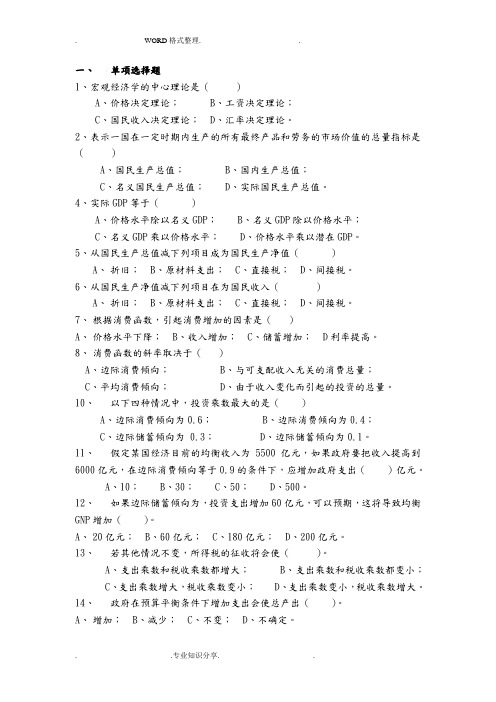
. WORD格式整理. .一、单项选择题1、宏观经济学的中心理论是()A、价格决定理论;B、工资决定理论;C、国民收入决定理论;D、汇率决定理论。
2、表示一国在一定时期内生产的所有最终产品和劳务的市场价值的总量指标是()A、国民生产总值;B、国内生产总值;C、名义国民生产总值;D、实际国民生产总值。
4、实际GDP等于()A、价格水平除以名义GDP;B、名义GDP除以价格水平;C、名义GDP乘以价格水平;D、价格水平乘以潜在GDP。
5、从国民生产总值减下列项目成为国民生产净值()A、折旧;B、原材料支出;C、直接税;D、间接税。
6、从国民生产净值减下列项目在为国民收入()A、折旧;B、原材料支出;C、直接税;D、间接税。
7、根据消费函数,引起消费增加的因素是()A、价格水平下降;B、收入增加;C、储蓄增加; D利率提高。
8、消费函数的斜率取决于()A、边际消费倾向;B、与可支配收入无关的消费总量;C、平均消费倾向;D、由于收入变化而引起的投资的总量。
10、以下四种情况中,投资乘数最大的是()A、边际消费倾向为0.6;B、边际消费倾向为0.4;C、边际储蓄倾向为 0.3;D、边际储蓄倾向为0.1。
11、假定某国经济目前的均衡收入为5500亿元,如果政府要把收入提高到6000亿元,在边际消费倾向等于0.9的条件下,应增加政府支出()亿元。
A、10;B、30;C、50;D、500。
12、如果边际储蓄倾向为,投资支出增加60亿元,可以预期,这将导致均衡GNP增加()。
A、20亿元;B、60亿元;C、180亿元;D、200亿元。
13、若其他情况不变,所得税的征收将会使()。
A、支出乘数和税收乘数都增大;B、支出乘数和税收乘数都变小;C、支出乘数增大,税收乘数变小;D、支出乘数变小,税收乘数增大。
14、政府在预算平衡条件下增加支出会使总产出()。
A、增加;B、减少;C、不变;D、不确定。
15、IS曲线向右方移动的经济含义是()。
(完整版)宏观经济学题库及答案

宏观经济学题库及答案1.宏观经济学的创始人是(A)。
A.斯密;B.李嘉图;C.凯恩斯;D.萨缪尔森。
2.宏观经济学的中心理论是(C)。
A.价格决定理论;B.工资决定理论;C.国民收入决定理论;D.汇率决定理论。
3.下列各项中除哪一项外,均被认为是宏观经济的“疾病”(D)。
A.高失业;B.滞胀;C.通货膨胀;D.价格稳定。
4.表示一国居民在一定时期内生产的所有最终产品和劳务的市场价值的总量指标是(A)。
A.国民生产总值;B.国内生产总值;C.名义国内生产总值;D.实际国内生产总值。
5.一国国内在一定时期内生产的所有最终产品和劳务的市场价值根据价格变化调整后的数值被称为(B)。
A.国民生产总值;B.实际国内生产总值;C.名义国内生产总值;D.潜在国内生产总值。
6.实际GDP等于(B)。
A.价格水平/名义GDP;B.名义GDP/价格水平×100;C.名义GDP乘以价格水平;D.价格水平乘以潜在GDP。
7.下列各项中属于流量的是(A)。
A.国内生产总值;B.国民债务;C.现有住房数量;D.失业人数。
8.存量是(A)。
A.某个时点现存的经济量值;B.某个时点上的流动价值;C.流量的固体等价物;D.某个时期内发生的经济量值。
9. 下列各项中哪一个属于存量?(C)。
A. 国内生产总值;B. 投资;C. 失业人数;D. 人均收入。
10.古典宏观经济理论认为,利息率的灵活性使得(B)。
A.储蓄大于投资;B.储蓄等于投资;C.储蓄小于投资;D.上述情况均可能存在。
11.古典宏观经济理论认为,实现充分就业的原因是(C)。
A.政府管制;B.名义工资刚性;C.名义工资灵活性;D.货币供给适度。
12.根据古典宏观经济理论,价格水平降低导致下述哪一变量减少(C)。
A.产出;B.就业;C.名义工资;D.实际工资。
13.在凯恩斯看来,造成资本主义经济萧条的根源是(A)。
A.有效需求不足;B.资源短缺;C.技术落后;D.微观效率低下。
中级经济师练习题库

中级经济师练习题库一、微观经济学1. 请简述消费者剩余的概念及其意义。
2. 生产企业为何会出现规模经济和规模不经济现象?3. 市场竞争与垄断对资源配置效率有何影响?4. 如何运用需求弹性理论分析商品价格变动对消费者需求量的影响?5. 简述生产要素价格的决定因素。
二、宏观经济学1. 什么是国内生产总值(GDP)?如何计算?2. 请解释通货膨胀和通货紧缩的概念及其影响。
3. 财政政策和货币政策如何影响宏观经济运行?4. 简述经济增长与经济发展的区别。
5. 分析我国近年来经济增长的动力来源。
三、金融学1. 请解释金融市场的基本功能。
2. 股票和债券的主要区别是什么?3. 金融机构如何进行风险管理和风险控制?4. 简述金融创新的含义及其作用。
5. 分析影响汇率变动的因素。
四、统计学与概率论1. 请解释统计学中的总体、样本和参数。
2. 如何计算一组数据的平均数、中位数和众数?3. 简述概率论中的大数定律和中心极限定理。
4. 如何利用线性回归模型进行预测分析?5. 请举例说明统计学在实际工作中的应用。
五、国际经济学1. 请简述比较优势理论的基本内容。
2. 国际贸易对国家经济发展有哪些影响?3. 世界贸易组织(WTO)的主要职能是什么?4. 简述汇率制度及其分类。
5. 分析影响国际资本流动的因素。
六、市场营销1. 请解释市场细分、目标市场和市场定位的概念。
2. 简述产品生命周期理论及其营销策略。
3. 如何制定有效的促销组合策略?4. 简述消费者购买决策过程。
5. 分析网络营销与传统营销的区别。
七、管理学1. 请简述泰勒的科学管理理论。
2. 管理者如何进行有效的沟通?3. 简述激励理论及其在企业管理中的应用。
4. 如何构建高效团队?5. 分析企业战略管理的层次与过程。
八、经济法1. 请简述合同法的基本原则。
2. 简述我国公司法对企业设立和变更的规定。
3. 如何理解反垄断法的意义和作用?4. 简述消费者权益保护法的主要内容。
中级宏观题库答案.doc

二、简述题(图解题)1、该恒等式仍然成立。
理巾(丨)国民收入核算中的恒等式中的储蓄和投资是真实产出中川于储蓄和投资的商品的价值总额。
(2)某人将部分现金存放在家里,所产生的效应相当于中央银行从货币市场中回笼了这笔现金。
即一定程度(轻微)的货币紧缩政策。
这一行为会影响经济体的产出,但不会破坏储蓄和投资之间的恒等关系。
3、自动稳定器是经济屮的一种机制,它自动减少为适应自主需求变动所需的产出变动:W:,政府不需要逐项加以干预;导致经济周期性起伏的主要原因是自主需求的变动,特别是投资耑求的变动,投资者乐观时投资耑求高涨,导致产出水平高涨;投资者悲观时投资耑求下降,导致产出水平下降。
比例所得税能起到自动稳定器的作用是因为经济体的税率水平会随经济的周期性变动而发生变化,并导致乘数# = _!_的变化。
经济繁荣时,整l-c(l-r)体税率水平t提高,导致乘数变小,自主投资耑求对均衡收入产生的乘数效应变小。
经济萧条吋,整体税率水平t下降,导致乘数变大,自主投资需求对均衡收入产生的乘数效应变大。
这意味着由于比例所得税的自动稳定器作用,经济周期性波动的幅度降低了(波峰岛度和波谷深度都降低了)。
4、现代菲利普斯曲线方程:7T = 7T e-e(U-U)o其中,7T为实际通货膨胀率,浐为预期通货膨胀率,W为实际失业率,:为自然失业率。
6•为大于零的常数。
现代菲利普斯曲线反映了通货膨胀率和失业率之间的反向关系,但经过了通过膨胀预期的调整。
滞胀指的是经济停滞和通货膨胀并存的现象,以用现代菲利普斯曲线来解释:图中的A 点和B点对比而言,A点表示失业率和通货膨胀率都很髙,它是一个滞胀点。
之所以会形成A点的滞胀状态,原因是A点所处的短期菲利普斯曲线的通货膨胀预期要大幅商于B点所处的短期菲利普斯曲线的通货膨胀预期。
一旦经济处于高通货膨胀预期的短期菲利普斯曲线上, 衰退将实际通货膨胀推导低于预期通货膨胀的水平,但通货膨胀的绝对水平仍然保持高水平。
- 1、下载文档前请自行甄别文档内容的完整性,平台不提供额外的编辑、内容补充、找答案等附加服务。
- 2、"仅部分预览"的文档,不可在线预览部分如存在完整性等问题,可反馈申请退款(可完整预览的文档不适用该条件!)。
- 3、如文档侵犯您的权益,请联系客服反馈,我们会尽快为您处理(人工客服工作时间:9:00-18:30)。
Name: __________________________ Date: _____________1.The rate of inflation is the:A)median level of prices.B)average level of prices.C)percentage change in the level of prices.D)measure of the overall level of prices.2.The definition of the transactions velocity of money is:A)money multiplied by prices divided by transactions.B)transactions divided by prices multiplied by money.C)money divided by prices multiplied by transactions.D)prices multiplied by transactions divided by money.3.If there are 100 transactions in a year and the average value of each transaction is $10,then if there is $200 of money in the economy, transactions velocity is ______ times per year.A)0.2B)2C)5D)104.If the transactions velocity of money remains constant while the quantity of moneydoubles, the:A)price of the average transaction must double.B)number of transactions must remain constant.C)price of the average transaction multiplied by the number of transactions mustremain constant.D)price of the average transaction multiplied by the number of transactions mustdouble.5.The quantity equation, viewed as an identity, is a definition of the:A)quantity of money.B)quantity of transactions.C)price level.D)transactions velocity of money.6.The income velocity of money:A)is defined in the identity MV = PY.B)is defined in the identity MV = PT.C)is the same thing as the transactions velocity of money.D)is the same as the number of times a dollar bill changes hands.7.The transactions velocity of money indicates the _____ in a given period, while theincome velocity of money indicates the _____ in a given period.A)number of transactions; amount of income earnedB)quantity of money used for transactions; quantity of money paid as incomeC)number of times a dollar bill changes hands; number of times a dollar bill enterssomeone's incomeD)volume of transactions; flow of income8.Real money balances equal the:A)sum of coin, currency, and balances in checking accounts.B)amount of money expressed in terms of the quantity of goods and services it canpurchase.C)number of dollars used as a medium of exchange.D)quantity of money created by the Federal Reserve.9.If the average price of goods and services in the economy equals $10 and the quantity ofmoney in the economy equals $200,000, then real balances in the economy equal:A)10.B)20,000.C)200,000.D)2,000,000.10.The demand for real money balances is generally assumed to:A)be exogenous.B)be constant.C)increase as real income increases.D)decrease as real income increases.11.If the quantity of real money balances is kY, where k is a constant, then velocity is:A)k.B)1/k.C)kP.D)P/k.12.If the demand for real money balances is proportional to real income, velocity will:A)increase as income increases.B)increase as income decreases.C)vary directly with the interest rate.D)remain constant.13.When the demand for money parameter, k, is large, the velocity of money is ______ andmoney is changing hands ______A)large; frequentlyB)large; infrequentlyC)small; frequentlyD)small; infrequently14.Consider the money demand function that takes the form (M/P)d= kY, where M is thequantity of money, P is the price level, k is a constant, and Y is real output. If the money supply is growing at a 10 percent rate, real output is growing at a 3 percent rate, and k is constant, what is the average inflation rate in this economy?A) 3 percentB)7 percentC)10 percentD)13 percent15.The income velocity of money increases and the money demand parameter k ______when people want to hold ______ money.A)increases; moreB)increases; lessC)decreases; moreD)decreases; less16.The quantity equation for money, by itself:A)may be thought of as a definition for velocity of money.B)implies that the velocity of money is constant.C)implies that the price level is proportional to the money supply.D)implies that real gross domestic product (GDP) is proportional to the moneysupply.17.The quantity theory of money assumes that:A)income is constant.B)velocity is constant.C)prices are constant.D)the money supply is constant.18.If income velocity is assumed to be constant, but no other assumptions are made, thelevel of ______ is determined by M.A)pricesB)incomeC)transactionsD)nominal GDP19.If velocity is constant and, in addition, the factors of production and the productionfunction determine real GDP, then:A)the price level is proportional to the money supply.B)real GDP is proportional to the money supply.C)the price level is fixed.D)nominal GDP is fixed.20.In the long run, according to the quantity theory of money and the classicalmacroeconomic theory, if velocity is constant, then ______ determines real GDP and ______ determines nominal GDP.A)the productive capability of the economy; the money supplyB)the money supply; the productive capability of the economyC)velocity; the money supplyD)the money supply; velocity21.According to the quantity theory of money, ultimate control over the rate of inflation inthe United States is exercised by:A)the Organization of Petroleum Exporting Countries (OPEC).B)the U.S. Treasury.C)the Federal Reserve.D)private citizens.22.According to the quantity theory of money, if money is growing at a 10 percent rate andreal output is growing at a 3 percent rate, but velocity is growing at increasingly faster rates over time as a result of financial innovation, the rate of inflation must be:A)increasing.B)decreasing.C)7 percent.D)constant.23.If the money supply increases 12 percent, velocity decreases 4 percent, and the pricelevel increases 5 percent, then the change in real GDP must be ______ percent.A)3B)4C)9D)1124.Percentage change in P is approximately equal to the percentage change in:A)M.B)M minus percentage change in Y.C)M minus percentage change in Y plus percentage change in velocity.D)M minus percentage change in Y minus percentage change in velocity.ing average rates of money growth and inflation in the United States over manydecades, Friedman and Schwartz found that decades of high money growth tended to have ______ rates of inflation and decades of low money growth tended to have ______ rates of inflation.A)high; highB)high; lowC)low; lowD)low; highing decade-long data across countries from 2000–2010, countries with high moneygrowth tend to have _____ inflation.A)highB)lowC)constantD)decreasing27.The right of seigniorage is the right to:A)levy taxes on the public.B)borrow money from the public.C)draft citizens into the armed forces.D)print money.28.“Inflation tax” means that:A)as the price level rises, taxpayers are pushed into higher tax brackets.B)as the price level rises, the real value of money held by the public decreases.C)as taxes increase, the rate of inflation also increases.D)in a hyperinflation, the chief source of tax revenue is often the printing of money.29.The inflation tax is paid:A)only by the central bank.B)by all holders of money.C)only by government bond holders.D)equally by every household.30.The percentage of government revenue raised by printing money has usually accountedfor:A)more than 10 percent of government revenue in the United States.B)less than 3 percent of government revenue in the United States.C)less than 3 percent of government revenue in Italy.D)less than 3 percent of government revenue in Greece.31.During the American Revolution, the price of gold measured in continental dollarsincreased to more than ______ times its previous level.A)2B)10C)50D)10032.The real interest rate is equal to the:A)amount of interest that a lender actually receives when making a loan.B)nominal interest rate plus the inflation rate.C)nominal interest rate minus the inflation rate.D)nominal interest rate.33.If the nominal interest rate is 1 percent and the inflation rate is 5 percent, the realinterest rate is:A) 1 percent.B) 6 percent.C)–4 percent.D)–5 percent.34.If the real interest rate declines by 1 percent and the inflation rate increases by 2 percent,the nominal interest rate must:A)increase by 2 percent.B)increase by 1 percent.C)remain constant.D)decrease by 1 percent.35.If the real interest rate and real national income are constant, according to the quantitytheory and the Fisher effect, a 1 percent increase in money growth will lead to rises in:A)inflation of 1 percent and the nominal interest rate of less than 1 percent.B)inflation of 1 percent and the nominal interest rate of 1 percent.C)inflation of 1 percent and the nominal interest rate of more than 1 percent.D)both inflation and the nominal interest rate of less than 1 percent.36.The one-to-one relation between the inflation rate and the nominal interest rate, theFisher effect, assumes that the:A)money supply is constant.B)velocity is constant.C)inflation rate is constant.D)real interest rate is constant.37.According to the quantity theory a 5 percent increase in money growth increasesinflation by ___ percent. According to the Fisher equation a 5 percent increase in the rate of inflation increases the nominal interest rate by _____.A)1; 5B)5; 1C)1; 1D)5; 538.According to the quantity theory and the Fisher equation, if the money growth increasesby 3 percent and the real interest rate equals 2 percent, then the nominal interest rate will increase:A) 2 percent.B) 3 percent.C) 5 percent.D) 6 percent.39.In the classical model, according to the quantity theory and the Fisher equation, anincrease in money growth increases:A)output.B)velocityC)the nominal interest rate.D)the real interest rate.40.Evidence from the past 40 years in the United States supports the Fisher effect andshows that when the inflation rate is high, the ______ interest rate tends to be ______.A)nominal; highB)nominal; lowC)real; highD)real; low41.The ex ante real interest rate is equal to the nominal interest rate:A)minus the inflation rate.B)plus the inflation rate.C)minus the expected inflation rate.D)plus the expected inflation rate.42.When a person purchases a 90-day Treasury bill, he or she cannot know the:A)ex post real interest rate.B)ex ante real interest rate.C)nominal interest rate.D)expected rate of inflation.43.Equilibrium in the market for goods and services determines the ______ interest rateand the expected rate of inflation determines the ______ interest rate.A)ex ante real; ex ante nominalB)ex post real; ex post nominalC)ex ante nominal; ex post realD)ex post nominal; ex post real44.The ex ante real interest rate is based on _____ inflation, while the ex post real interestrate is based on _____ inflation.A)expected; actualB)core; actualC)actual; expectedD)expected; core45.According to the Fisher effect, the nominal interest rate moves one-for-one withchanges in the:A)inflation rate.B)expected inflation rate.C)ex ante real interest rate.D)ex post real interest rate.46.A positive relationship between nominal interest rates and inflation in the United Statesis obvious in:A)both recent data and nineteenth-century data.B)recent data but not nineteenth-century data.C)nineteenth-century data but not recent data.D)neither nineteenth-century data nor recent data.47.The ex post real interest rate will be greater than the ex ante real interest rate when the:A)rate of inflation is increasing.B)rate of inflation is decreasing.C)actual rate of inflation is greater than the expected rate of inflation.D)actual rate of inflation is less than the expected rate of inflation.48.In recent U.S. experience, inflation has:A)been persistent from year to year, whereas in the nineteenth century inflation hadlittle persistence.B)been persistent from year to year, and this was also true in the nineteenth century.C)not been persistent from year to year, although it was persistent in the nineteenthcentury.D)not been persistent from year to year, and the same was true in the nineteenthcentury.49.The opportunity cost of holding money is the:A)nominal interest rate.B)real interest rate.C)federal funds rate.D)prevailing Treasury bill rate.50.The real return on holding money is:A)the real interest rate.B)minus the real interest rate.C)the inflation rate.D)minus the inflation rate.51.If the real return on government bonds is 3 percent and the expected rate of inflation is 4percent, then the cost of holding money is ______ percent.A)1B)3C)4D)752.The general demand function for real balances depends on the level of income and the:A)real interest rate.B)nominal interest rate.C)rate of inflation.D)price level.53.If the nominal interest increases, then:A)the money supply increases.B)the money supply decreases.C)the demand for money increases.D)the demand for money decreases.54.Consider the money demand function that takes the form (M/P)d = Y/4i, where M is thequantity of money, P is the price level, Y is real output, and i is the nominal interest rate.What is the average velocity of money in this economy?A)iB)4iC)1/4iD)0.2555.If the Fed announces that it will raise the money supply in the future but does notchange the money supply today,A)both the nominal interest rate and the current price level will decrease.B)the nominal interest rate will increase and the current price level will decrease.C)the nominal interest rate will decrease and the current price level will increase.D)both the nominal interest rate and the current price level will increase.56.If the money supply is held constant, then an increase in the nominal interest rate will______ the demand for money and ______ the price level.A)increase; increaseB)increase; decreaseC)decrease; increaseD)decrease; decrease57.If the demand for money depends on the nominal interest rate, then via the quantitytheory and the Fisher equation, the price level depends on:A)only the current money supply.B)only the expected future money supply.C)both the current and expected future money supply.D)neither the current nor the expected future money supply.58.According to the classical theory of money, reducing inflation will not make workersricher because firms will increase product prices ______ each year and give workers ______ raises.A)more; largerB)more; smallerC)less; largerD)less; smaller59.According to the classical theory of money, inflation does not make workers poorerbecause wages increase:A)faster than the overall price level.B)more slowly than the overall price level.C)in proportion to the increase in the overall price level.D)in real terms during periods of inflation.60.Survey evidence indicates that economists worry ______ the general public does aboutprices increasing more rapidly than their incomes.A)more thanB)less thanC)about the same asD)more intensely than61.Which of the following is NOT an effect of expected inflation?A)causes lower real wages.B)leads to shoeleather costs.C)increases menu costs.D)leads to taxing of nominal capital gains that are not real.62.The inconvenience associated with reducing money holdings to avoid the inflation tax iscalled:A)menu costs.B)shoeleather costs.C)variable yardstick costs.D)fixed costs.63.The costs of reprinting catalogs and price lists because of inflation are called:A)menu costs.B)shoeleather costs.C)variable yardstick costs.D)fixed costs.64.Inflation ______ the variability of relative prices and ______ allocative efficiency.A)increases; increasesB)increases; decreasesC)decreases; decreasesD)decreases; increases65.Devoting resources to avoiding the costs of expected inflation leads to:A)eliminating the costs of expected inflation.B)fewer relative price changes.C)economic inefficiency.D) a decrease in the transaction velocity of money.66.Variable inflation hurts both debtors and creditors because:A)inflation makes the money-fixed assets of creditors worth less.B)inflation makes the money-fixed liabilities of debtors worth less.C)most debtors and creditors are risk averse.D)most debtors and creditors are risk neutral.67.In the case of an unanticipated inflation:A)creditors with an unindexed contract are hurt because they get less than theyexpected in real terms.B)creditors with an indexed contract gain because they get more than they contractedfor in nominal terms.C)debtors with an unindexed contract do not gain because they pay exactly what theycontracted for in nominal terms.D)debtors with an indexed contract are hurt because they pay more than theycontracted for in nominal terms.68.The costs of unexpected inflation, but not of expected inflation, are:A)menu costs.B)the arbitrary redistribution of wealth between debtors and creditors.C)unintended distortions of individual tax liabilitiesD)the costs of relative price variability.69.Between 1880 and 1896, the price level in the United States fell 23 percent. Thismovement was ______ for bankers of the Northeast and ______ for farmers of theSouth and West.A)bad; badB)good; goodC)good; badD)bad; good70.A variable rate of inflation is undesirable because:A)debtors and creditors cannot protect themselves by indexing contracts.B)shoeleather costs are greater under variable inflation than under constant inflation.C)menu costs are greater under variable inflation than under constant inflation.D)variable inflation leads to greater uncertainty and risk as compared to constantinflation.71.One possible benefit of moderate inflation is:A) a reduction in boredom attributable to the changing prices.B)the elimination of menu costs.C)better functioning labor markets.D)increased certainty about the future.72.If inflation is 6 percent and a worker receives a 4 percent nominal wage increase, thenthe worker's real wage:A)increased 4 percent.B)increased 2 percent.C)decreased 2 percent.D)decreased 6 percent.73.If nominal wages cannot be cut, then the only way to reduce real wages is by:A)adjustments via inflation.B)unions.C)legislation.D)productivity increases.74.A rate of inflation that exceeds 50 percent per month is typically referred to as a(n):A)conflagration.B)hyperinflation.C)deflation.D)disinflation.pared to periods of lower rates of inflation, during a hyperinflation all of thefollowing occur except:A)shoeleather costs increase.B)menu costs become larger.C)relative prices do a better job of reflecting true scarcity.D)tax distortions increase.76.Hyperinflations ultimately are the result of excessive growth rates of the money supply;the underlying motive for the excessive money growth rates is frequently agovernment's:A)desire to increase prices throughout the economy.B)need to generate revenue to pay for spending.C)responsibility to increase nominal interest rates by increasing expected inflation.D)inability to conduct open-market operations.77.Which of the following would most likely be called a hyperinflation?A)Price increases averaged 300 percent per year.B)The inflation rate was 10 percent per year.C)Real GDP grew at a rate of 12 percent over a year.D) A stock market index rose by 1,000 points over a year.78.In instances of hyperinflation, the delays involved in collecting taxes often result in:A)decreased real government tax revenue.B)large capital gains for creditors.C)higher shoeleather costs of inflation.D)higher ex ante real interest rates.79.During hyperinflation real tax revenue of the government often drops substantiallybecause of the:A)delay between when a tax is levied and when it is collected.B)significantly greater menu costs of printing tax forms.C)additional deductions taken for increased shoeleather costs.D)greater uncertainty associated with extreme rates of inflation.80.The major source of government revenue in most countries that are experiencinghyperinflation is:A)customs duties.B)income taxes.C)seigniorage.D)borrowing.81.In practice, in order to stop a hyperinflation, in addition to stopping monetary growth,the government must:A)lower taxes and raise government spending.B)raise taxes and reduce government spending.C)change from one kind of currency to another.D)call for a new election.82.To end a hyperinflation, a government trying to reduce its reliance on seignioragewould:A)print more money.B)raise taxes and cut spending.C)lower taxes and increase spending.D)lower interest rates.83.Most hyperinflations end with _____ reforms that eliminate the need for _____.A)monetary; taxesB)monetary; currencyC)fiscal; seigniorageD)fiscal; currency84.The hyperinflation experienced by interwar Germany illustrates how fiscal policy can beconnected to monetary policy when government expenditures are financed by:A)new taxes.B)borrowing in the open market.C)printing large quantities of money.D)selling gold.85.In Zimbabwe in the 1990s the government resorted to printing money to pay the salariesof government employees because:A)it was a means to avoid price controls.B)of high rates of inflation.C)of declining tax revenues.D)of a need to stimulate the economy.86.Which of the following is an example of a relative price?A)the real interest rateB)the capital stockC)the dollar wage per hourD)the price level87.Variables expressed in terms of physical units or quantities are called ______ variables.A)realB)nominalC)endogenousD)exogenous88.Variables expressed in terms of money are called ______ variables.A)realB)nominalC)endogenousD)exogenous89.An example of a real variable is the:A)dollar wage a person earns.B)quantity of goods produced in a year.C)price level.D)nominal interest rate.90.An example of a nominal variable is the:A)money supply.B)quantity of goods produced in a year.C)relative price of bread.D)real wage.91.The classical dichotomy:A)cannot hold if money is “neutral.”B)is said to hold when the values of real variables can be determined without anyreference to nominal variables or the existence of money.C)fully describes the world in which we live, especially in the short run.D)arises because money depends on the nominal interest rate.92.According to the classical dichotomy, when the money supply decreases, _____ willdecrease.A)real GDPB)consumption spendingC)the price levelD)investment spending93.The concept of monetary neutrality in the classical model means that an increase in themoney supply will increase:A)real GDP.B)real interest rates.C)nominal interest rates.D)both saving and investment by the same amount.94.The characteristic of the classical model that the money supply does not affect realvariables is called:A)the monetary basis.B)monetary policy.C)the quantity theory of money.D)monetary neutrality95.The theoretical separation of real and monetary variables is called:A)the classical dichotomy.B)monetary neutrality.C)the Fisher effect.D)the quantity theory of money.96.If the price level depends on both the current money supply and future expected moneysupplies, in order to stop a hyperinflation, a central bank may try to establish credibility by:A)achieving increased political independence from the government.B)increasing revenue from seigniorage.C)encouraging increased government spending and tax cuts.D)undertaking larger open-market purchases.97.A small country might want to use the money of a large country rather than print its ownmoney if the small country:A)is likely to be unstable, whereas the large country is likely to be stable.B)is likely to be stable, whereas the large country is likely to be unstable.C)needs the revenue for seigniorage.D)wants to control its own inflation rate.98.The phrase “inflation is repudiation” applies only if:A)inflation is expected.B)the government has no debt.C)the government is a creditor.D)the government is a debtor.99.If consumption depends positively on the level of real balances, and real balancesdepend negatively on the nominal interest rate in a neoclassical model, then:A)the classical dichotomy still holds.B) a rise in money growth leads to a fall in consumption and a rise in investment.C) a rise in money growth leads to a rise in consumption and a fall in investment.D) a rise in money growth leads to a rise in both consumption and investment.100.If consumption depends positively on the level of real balances and real balances depend negatively on the nominal interest rate in a neoclassical model, then the nominalinterest rate:A)declines when the money growth rate rises.B)is unchanged when the money growth rate rises.C)rises 1 percent for each 1 percent rise in the money growth rate.D)rises less than 1 percent for each 1 percent rise in the money growth rate.101.Assume that a series of inflation rates is 1 percent, 2 percent, and 4 percent, while nominal interest rates in the same three periods are 5 percent, 5 percent, and 6 percent,respectively.a.What are the ex post real interest rates in the same three periods?b.If the expected inflation rate in each period is the realized inflation rate in the previousperiod, what are the ex ante real interest rates in periods two and three?c.If someone lends in period two, based on the ex ante inflation expectation in part b, will heor she be pleasantly or unpleasantly surprised in period 3 when the loan is repaid?102.Mary Tsai is paid $3,000 every 30 days. Her salary is deposited directly in her bank.She spends all her money at a constant rate over the 30 days and must pay cash. She can(1) withdraw all of the money at once; (2) withdraw half at once and the rest after 15days; (3) withdraw one-third at once, one-third after 10 days, and one-third at 20 days;or (4) make any number of evenly spaced withdrawals. Each withdrawal costs her $2 interms of time and inconvenience. For each day that Mary has a dollar in the bank, shegets .03 cents (.0003 per dollar) in interest. Thus, if she withdraws half of her moneyimmediately and half in 15 days, she has $1,500 in the bank for 15 days and earns $6.75interest.a.Create a table showing transaction costs, interest earned, and total net earnings (+) or cost (–)associated with one, two, three, or four withdrawals per month.b.How many withdrawals per month lead to the largest net earnings? If Mary chooses thisnumber, what will be her average amount of cash on hand over the 30 days?103.Assume that the demand for real money balance (M/P) is M/P = 0.6Y – 100i, where Y is national income and i is the nominal interest rate (in percent). The real interest rate r isfixed at 3 percent by the investment and saving functions. The expected inflation rateequals the rate of nominal money growth.a.If Y is 1,000, M is 100, and the growth rate of nominal money is 1 percent, what must i and Pbe?b.If Y is 1,000, M is 100, and the growth rate of nominal money is 2 percent, what must i andP be?104.A classical economist wears a T-shirt printed with the slogan “Fast Money Raises My Interest!” Use the quantity theory of money and the Fisher equation to explain theslogan.105.In classical macroeconomic theory, the concept of monetary neutrality means that changes in the money supply do not influence real variables. Explain why changes inmoney growth affect the nominal interest rate, but not the real interest rate.106.Econoland finances government expenditures with an inflation tax.a.Explain who pays the tax and how it is paid.b.What are costs of the tax, assuming the tax rate is expected?。
